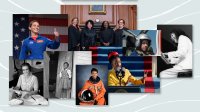When Black History Meets Women’s History
Recognizing overlapping identities in different heritage months allows students to examine the complexity of the human experience.
As much as the monthlong opportunities to celebrate diverse narratives and achievements have given rise to more acceptance of diversity, the singular nature of that celebration can sometimes unintentionally overlook the rich tapestry of intersectional identities that many of us embody.
Intersectionality is an academic word that each of us lives out daily. We are educators, sons, mothers, friends, partners, coaches; women and Indigenous; Black and male; teachers and members of the LGBTQ+ community. Our identities can come together harmoniously, discordantly, or somewhere in between.
February and March (as well as other monthlong identity celebrations) provide us with the opportunity not only to highlight one heritage or identity, but also to educate ourselves and our students on how the intersection of our identities can shape us.
Pioneers of the Past and Their Impact Today
Katherine Johnson is one example. One of the first Black female mathematicians to work for NASA (then the National Advisory Committee for Aeronautics, or NACA), Katherine Johnson experienced discrimination as both a woman and a Black person on her journey. A stellar student, Johnson graduated from West Virginia State College at only 18 with a bachelor’s degree in French and, of course, one in her first love, math.
However, in the 1930s, Black women were homemakers and often domestic workers, nurses, or teachers because opportunities were scarce. Johnson became a teacher after graduating, then married and did what women of her era were supposed to do. Only when her husband fell ill did Johnson reenter the workforce, and the rest, as they say, is history.
What questions should Johnson’s journey prompt in today’s classrooms?
- What do you think were some of the roles and identities Katherine Johnson held (wife, mother, teacher, mathematician)?
- Which of those identities made life easier for Johnson in the 1930s? Which presented more challenges and why?
- How might those same identities influence Johnson’s journey today and why?
- What are some of the roles and identities that you hold (student, daughter, “first gen,” gamer, basketball player, avid reader)?
- What roles and identities are you most comfortable with? Which ones are you more likely to keep to yourself, if possible?
Encourage Reflection to Support Empathy and Pride
When reflecting on their own identities, students may express varying levels of comfort with parts of who they are. Indigenous students may feel invisible in today’s curriculum, non-White or bilingual students may express being consistently viewed as lower performing, boys may feel pressure to be athletic, and girls may feel pressured to be pretty and popular.
Hopefully, every group will also express pride in who they are. Conversations like these can help students build empathy for others while they build self-esteem. Student self-esteem correlates directly to better academic outcomes and better mental health and well-being.
Consider New Influential Trailblazers
Katherine Johnson is probably not the first face we think of when we think of NASA or STEM subjects. When we think about STEM contributions, we usually think of Einstein, Jobs, Musk, and perhaps adding Hawking for diversity. But what if we could expose our female students—still underrepresented in STEM careers—to role models they can follow on their favorite social media platforms?
Tai-Danae Bradley is a professor and research mathematician who has all the “rizz” to draw girls into conversations where quantum physics and algebraic concepts intersect. And while it’s almost embarrassing to even mention Dr. Bradley’s charisma in 2023, knowing a math influencer who can hold her own in the era of social media with math is incredibly valuable, especially to parents and educators who compete with those platforms for our students’ attention daily.
Here are some other notable “sheroes” your students can follow on social media:
- Amanda Gorman, our nation’s youngest inaugural poet and cum laude Harvard grad
- Supreme Court justices Sonia Sotomayor, Elena Kagan, Amy Coney Barrett, and Ketanji Brown Jackson
- Toshiko Akiyoshi, jazz musician
- Ruby Bridges, civil rights icon
As we highlight historically significant achievements of diverse populations, we can also use living, breathing examples so that our students can see themselves in those who influence world events today. I created an activity students can use to explore the impact of significant figures. They’ll learn about amazing people who changed the world, discover who they are and why they matter, and compare them with others their age.
The beauty of heritage months is that we can celebrate not only Black people or women this time of year, but also connections and intersections. Katherine Johnson lived to see Mae Jemison rising to heights that women of her time could not have imagined. As a matter of fact, Katherine Johnson lived to see Dr. Jemison, Dr. Ellen Ochoa, Nicole Aunapu Mann, and many others for whom she had paved the way. Those women will live to see both Christina Koch and Victor Glover, an African American naval aviator, fly to the moon.
These intersections and bridges are valuable to remember during heritage celebrations so we can continue to remember that there is always more that connects us—more at the intersection of our sameness than the abyss we sometimes feel divides us.
